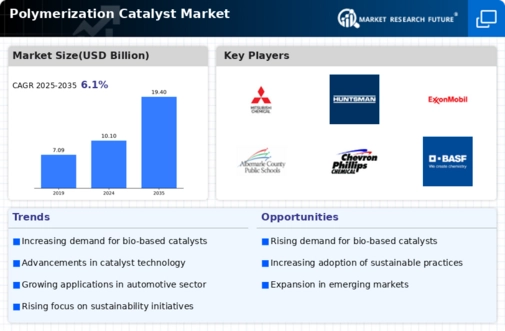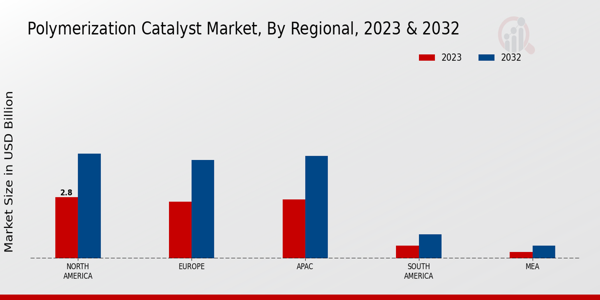Market Growth Chart
Expansion of End-Use Industries
The expansion of end-use industries significantly influences the Global Polymerization Catalyst Market Industry. Sectors such as automotive, electronics, and healthcare are increasingly utilizing polymers for various applications, thereby driving the demand for effective polymerization catalysts. For instance, the automotive industry is adopting lightweight polymer materials to enhance fuel efficiency and reduce emissions. This trend is expected to propel the market forward, with projections indicating a growth trajectory that could see the industry reach 19.4 USD Billion by 2035, reflecting the increasing reliance on polymers across diverse applications.
Increasing Regulatory Compliance
Increasing regulatory compliance regarding environmental standards is a significant driver for the Global Polymerization Catalyst Market Industry. Governments worldwide are implementing stringent regulations to minimize the environmental impact of polymer production, prompting manufacturers to adopt cleaner and more efficient catalytic processes. This shift towards compliance not only enhances sustainability but also encourages the development of innovative catalysts that align with regulatory requirements. As companies strive to meet these standards, the demand for advanced polymerization catalysts is expected to rise, contributing to the overall growth of the market.
Rising Demand for Sustainable Polymers
The Global Polymerization Catalyst Market Industry experiences a notable surge in demand for sustainable polymers, driven by increasing environmental awareness and regulatory pressures. Industries such as packaging, automotive, and construction are shifting towards eco-friendly materials, which often require advanced catalysts for efficient polymerization processes. For instance, biopolymers derived from renewable resources are gaining traction, necessitating innovative catalytic solutions. This trend is projected to contribute significantly to the market's growth, with the industry expected to reach 10.1 USD Billion in 2024, reflecting a growing preference for sustainable alternatives in polymer production.
Technological Advancements in Catalysis
Technological advancements in catalysis play a pivotal role in shaping the Global Polymerization Catalyst Market Industry. Innovations in catalyst design, such as the development of more efficient and selective catalysts, enhance polymerization processes, leading to improved product quality and reduced production costs. For example, the introduction of metallocene catalysts has revolutionized the production of polyethylene and polypropylene, enabling manufacturers to create polymers with tailored properties. These advancements are likely to drive market growth, as companies seek to optimize their production processes and meet the evolving demands of consumers and regulatory bodies.
Growing Investment in Research and Development
Growing investment in research and development (R&D) within the Global Polymerization Catalyst Market Industry is fostering innovation and enhancing product offerings. Companies are allocating substantial resources to develop novel catalysts that improve efficiency and sustainability in polymer production. This focus on R&D is evident in collaborations between academia and industry, leading to breakthroughs in catalyst technology. As a result, the market is likely to benefit from the introduction of advanced catalytic solutions that meet the stringent requirements of modern manufacturing processes, ultimately driving growth and competitiveness in the sector.











